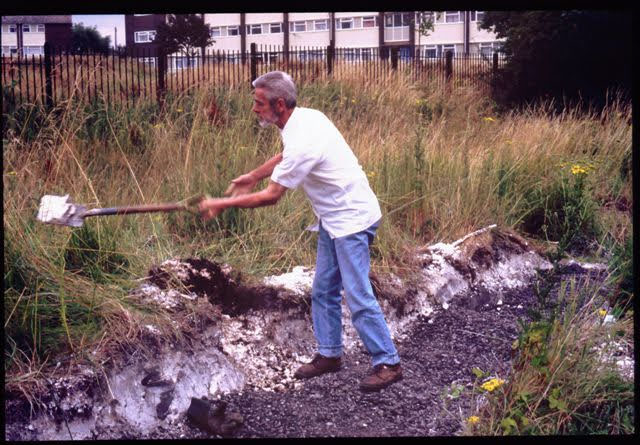Having got the lease, we all took a bit of a rest for a
few months over winter, then started tackling the site in earnest in spring
1994. The first workday to start shifting fly-tipped rubbish was on 21 May.
Over that summer many things got done. Mel had done grant applications in other
community roles, so knew how to set about it. Our first grant, from English
Nature, hired a JCB to clear the mound of soil from the entrance (the soil made
the ridge between the perching wall and the siding). That mound has been put
across the entrance road some years before to stop travellers and fly-tippers
accessing the site. It is now between the perching wall and the siding.
 |
| Mel hard at work on the lime waste area |
We needed to fence the short southern edge of the park for security – vandalism, trespass and petty crime were still very much present. We rapidly realised we couldn’t fence all along the approach road with security fencing - the cost would have been enormous – so we decided to fence across level with the railway engineer’s fence and gate, which needed a short run of about 40m but secured the vast majority of the site. The estimate was £4600 – in 1994 a major sum, especially for a new project to find. We eventually found the money from 2 separate grants. One involved some rapid work. We were told on one Thursday of a grant available through RSNC (now The Wildlife Trusts national office), but the application had to be in on Friday and a postal strike had just ended, so the post was massively delayed. One of the council officers involved with us, Steve Foden, had access to a fax machine (remember this is all long pre-email and internet). The form was faxed to there, Hilary collected it and filled it in (we had all the estimates and information ready thank goodness), she picked up the children from school on Friday and took them and the form to the council office, from where it was faxed though with a note to say the supporting information would be in the post on the Saturday. We got the grant! The fence was installed in October 1994 and we heaved a sigh of relief that the worst of the vandalism was now fenced out.
Mel always called himself “the world’s best scrounger” –
but all for the community things he was involved in, never for himself. As we
cleared masses of fly-tipped rubbish to the road inside the gate, he persuaded
Wirral Borough Council to collect it with their bin lorries for free. 7 wagon-loads went that
first summer, and several more the next year. Meanwhile, the railway decided to
replace the western (rail-side) chain-link fence with a security fence, greatly
to our relief as the fence was nominally, according to the lease, our
responsibility, and panels of chain-link had a habit of walking off-site to
local pigeon lofts. Mel scrounged some of the old fencing to make our first
compost bins. Mel insisted on taking part in the workdays (then and for several
years fortnightly on Sundays, plus some weekday work especially by Howard and
Mel). Mel hid the pain he was often in, but usually spent the day after a
workday in bed for his back to recover.
 |
| Volunteers at one of the workdays |
An early achievement in making the Park so successful was the tool container, thanks to a grant found by Gordon Reid and Mel doing the planning application. It makes events so much easier to organise by solving the tool logistics, so there are no limits to volunteers because of tools.
It also provides central storage space for the educational materials, the Wirral Wildlife gazebo and tables, and the all-important tea boiler and refreshment supplies. Volunteer workdays still run on tea and coffee!



No comments:
Post a Comment